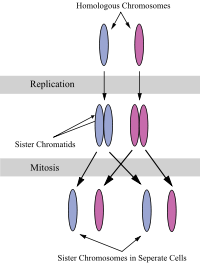
Sister chromatids
Encyclopedia

Chromatid
A chromatid is one of the two identical copies of DNA making up a duplicated chromosome, which are joined at their centromeres, for the process of cell division . They are called sister chromatids so long as they are joined by the centromeres...
connected by a centromere
Centromere
A centromere is a region of DNA typically found near the middle of a chromosome where two identical sister chromatids come closest in contact. It is involved in cell division as the point of mitotic spindle attachment...
. Compare sister chromatids to homologous chromosome
Homologous chromosome
Homologous chromosomes are chromosome pairs of approximately the same length, centromere position, and staining pattern, with genes for the same characteristics at corresponding loci. One homologous chromosome is inherited from the organism's mother; the other from the organism's father...
s, which are the two different copies of the same chromosome that diploid organisms (like humans) inherit, one from each parent. In other words, sister chromatids contain the same genes and same alleles, and homologous chromosomes contain the same genes but two copies of alleles, each of which might or might not be the same as each other.
A full set of sister chromatids is created during the S subphase of interphase
Interphase
Interphase is the phase of the cell cycle in which the cell spends the majority of its time and performs the majority of its purposes including preparation for cell division. In preparation for cell division, it increases its size and makes a copy of its DNA...
, when all the DNA in a cell is replicated. Identical chromatid pairs are separated into two different cells during mitosis
Mitosis
Mitosis is the process by which a eukaryotic cell separates the chromosomes in its cell nucleus into two identical sets, in two separate nuclei. It is generally followed immediately by cytokinesis, which divides the nuclei, cytoplasm, organelles and cell membrane into two cells containing roughly...
, or cellular division.
There is evidence that, in some species, sister chromatids are the preferred template for DNA repair.
Sister chromatid cohesion is essential for the correct distribution of genetic information between daughter cells and the repair of damaged chromosomes. Defects in this process may lead to aneuploidy and cancer, especially when checkpoints fail to detect DNA damage or when incorrectly attached mitotic spindles do function properly.

